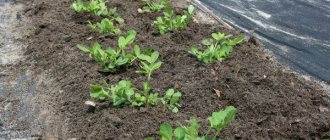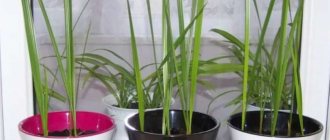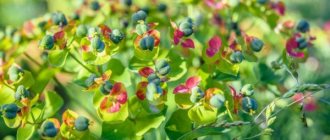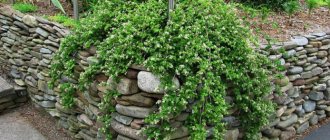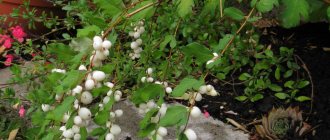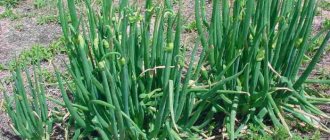Loading…
Loading…
September or Virginia aster is a perennial plant that decorates many gardens with lush and bright flowering that lasts until the onset of the first frost. Reproduction, planting and caring for September flowers do not cause any difficulties and do not take much time, which has ensured the plant’s love among many summer residents and gardeners.
Varieties of perennial asters
New Belgian.
It has several types of colors from bright purple to pale pink. The petals are small, resembling a fringe. It is divided into two types - low-growing and tall-growing. The latter can reach 180 cm. Blooms in September-October. It can bloom already indoors in a vase. Easily affected by powdery mildew. Shrub. It got its name because it grows in the form of a spherical bush. It has the same shades as other September varieties, but the flowers are more voluminous. The plant does not require special care and is disease resistant.
New England. It surpasses many other September varieties in height, and can grow up to 150 cm. The flowers are slightly larger than those of the bush variety. The petals are curved upward and give the flower a bowl shape. Due to their tall growth, New England asters require support. Resistant to powdery mildew.
Italian chamomile. The shape is an absolute daisy, but the color of the petals is traditional for September flowers, predominantly blue, light blue, pale lilac. The flowers are larger than other varieties. It grows up to 70 cm. It blooms already in mid-August and pleases with flowers until the second half of October. The Italian chamomile aster is not afraid of powdery mildew, but is capricious during reproduction. The process of rooting cuttings can be delayed if there is not enough lime and a lot of moisture in the soil.
Freecard. This is a hybrid of two varieties: Italian and Thomson. Similar in shape to a daisy with blue flowers. The flowers are large and dense. It blooms already in July and fades in October. Not afraid of fungal diseases.
Pyrenean. Flowers can have a gradient color. The petals are darker in the middle and paler on the outer edge. The shape of the flowers is round, even spherical. The color is pale lilac. Blooms from August to October.
September flowers in landscape design and in combination with other flowers in the garden
When placing nets in the garden, it is necessary to take into account their late flowering. Tall varieties are used in single plantings. Bushes can be used to disguise unsightly buildings and fences. Low varieties are used in mixborders, combining them with plantings of Korean chrysanthemums to select the appropriate color scheme and flowering time.
September flowers are planted in the background of the ridges. In the foreground of the ridges, annual flowers are placed, the beauty of which will be emphasized by the openwork foliage, and when the flowering of the annual flowers ends, there will be a bright riot of colors of September flowers. For discounts, low varieties are selected.
You can use decorative September foliage to arrange bouquets.
Seed growing method
It is better to purchase seeds for seedlings in the store, since it is almost impossible to prepare them yourself due to the late flowering period - the seeds simply do not have time to ripen. If, nevertheless, you manage to collect them, then they will not be able to please you with good germination, and the shelf life is very short.
Reference! It is better to sow seeds in late February - the seedlings will have time to grow stronger and harden before being planted in the ground.
Landing rules
The soil mixture must be poured into containers in advance and disinfected with a pink solution of potassium permanganate. Purchased seeds are usually already processed and ready for planting.
They should be distributed over shallow (0.5 cm) grooves, covered with dry soil, then moistened with a spray bottle. Then cover the containers with a transparent material (glass, film) and place in a warm, well-lit place. The greenhouse needs to be ventilated daily to remove condensation.
As soon as shoots appear, and this happens after 21-28 days, the shelter should be removed. Soil moisture is important for young sprouts, so watering should be regular, but waterlogging should not be allowed, otherwise the sprouts will die.
Picking into separate containers is carried out when there are 3-4 leaves. After a little more than a week, when the seedlings have become stronger, you can feed them with mineral complexes. In May, 10-12 days before planting seedlings in the ground, you need to start hardening them. To do this, boxes with seedlings are taken out onto the balcony, veranda, and the windows are opened.
Transplanting
Since the crop is late-flowering, you need to choose a sunny area to grow it - lack of lighting will affect the quality of flowering. You should also provide protection from draft winds and proximity to other plants, because the root system of September flowers grows greatly and can harm low-growing perennials.
On a note! The crop has no special requirements for soil - it does well in any soil except loam. Important points: in the spring, water should not accumulate on the site after the snow melts, otherwise the roots will simply get wet and rot, and do not plant moisture-loving plants nearby - drought-resistant September takes a lot of water from the soil.
The area for planting must be prepared in advance, 1-2 weeks in advance, so that the soil settles and becomes structured. To do this, it should be dug up and organic and mineral fertilizers applied.
The size of the holes depends on the size of the roots of the seedlings, and the distance between them is determined by the variety and planting pattern, but it is not recommended to plant bushes close to each other due to the growth of the root system and branches.
Before planting, the holes need to be watered, when the moisture is absorbed, place the seedlings, cover with soil, lightly compact and moisten.
Stages of care
Caring for September flowers consists of the usual procedures of watering, weeding, loosening, fertilizing and pruning:
- young seedlings need to be watered regularly, avoiding waterlogging and drying out of the soil;
- when the root system gets stronger, it is enough to water once a week;
- regularly remove weeds and loosen the soil so that a crust does not form;
- It is recommended to apply nitrogen-containing fertilizers for the first time in the spring, feed with organic matter and potassium complexes at least 3 times during the summer (alternate), and apply fertilizers with phosphorus during the flowering period;
- Regular removal of dried leaves and wilted buds prolongs flowering time and improves its quality;
- if the bush has lost its decorative appearance, then you can trim off unnecessary shoots;
- after the onset of permanent frosts, trim the stem, leaving low stumps (3 cm).
Information! The culture is frost-resistant and does not require shelter for the winter. After pruning, it is enough to cover the bushes with dry leaves or cover them with pine branches.
Transfer
Perennial September flowers can grow in one place for more than one year, but the soil is gradually depleted, the root system grows greatly and deteriorates the soil structure, so it is necessary to replant the plant every 2-3 years.
It is best to transplant in the spring, when the frost season has passed. It is convenient to combine it with dividing the bush to propagate the variety you like. By autumn, the bushes will take root and be ready for frost, and in the fall there is a high probability that the root system will not have time to become sufficiently strong.
When replanting, it is imperative to remove coarse old roots and shoots and it is advisable to build restrictions in the soil that prevent the roots from spreading, which quickly occupy the nearby space.
Planting in open ground
When the seedlings are strong enough, they are planted in open ground. But before that, you should choose a place and prepare the ground.
Selecting a location
September flowers are not capricious, so they grow well in any soil except loamy soil. When choosing a place to plant seedlings, it is better to give preference to a sunny area without drafts. Preferably on a hill to avoid possible flooding.
Soil preparation
2 weeks before planting the seedlings, the area is prepared. To do this, they dig it up and apply fertilizer. These can be organic or mineral compounds.
Planting scheme
For planting, holes are dug; their depth must correspond to the root system of the seedlings. Fill them with water, and after it has been absorbed a little, plant the seedlings.
The distance between plants should be about 50 cm. If this is planting above paths, you can reduce it to 20 cm.
Planting and care
Flowers prefer areas with slightly acidic nutrient soil and good lighting. But they will grow even on scanty and alkaline loam, but the bushes will not be so beautiful and lush.
But octopus will not take root on swampy soil. In deep shade they will grow, but will not bloom. In this case, perennial asters can be used instead of light-loving shrubs for landscaping.
The distance between adjacent plantings should be 40–50 cm. If the variety is short, you can reduce it to 20–25 cm. Before planting asters, you need to dig up the ground and apply organic and mineral fertilizers. In loose and nutritious soil, seedlings will take root faster.
Dig small holes for the seedlings, then water the soil thoroughly. Place perennial asters and cover the roots with soil and compact the stems with soil. After all the steps have been completed, water the plantings with plenty of water.
If you want to achieve especially long and active flowering, fertilize the plants:
- in spring - nitrogen and organic matter;
- during budding - potassium and magnesium.
But even if you don’t feed the October flowers, they will still bloom.
During the growing season, the plant will need to be looked after. Remove and weed weeds, loosen the top layer of soil and water the plants regularly. If asters do not have enough water, their roots will become even longer. With their help, the October plant will begin to take all the moisture from the soil. But waterlogging will provoke a black leg.
There is no need to install a shelter for adult perennial asters for the winter. But be sure to cover the planted plants. For the first time, you can use spruce branches or fallen leaves for this. And next year, don’t do anything.
Reproduction of October flowers
The easiest way to propagate is by dividing the bush. Perform the procedure in the spring.
- Dig up a perennial aster that is at least 4 years old. Shake off the root system from the lump of soil, this will make planting easier.
Divide the root into several parts. You can plant the plant alone, in pairs or in a group. Dig a small hole for each division. If you have the opportunity, add organic fertilizers to it. If not, then don’t worry - perennial asters will take root just fine without it.
There are also other ways to propagate perennial asters:
- Root sections. In the spring, when digging a flower bed, divide the extracted roots of perennial asters into several parts. In this case, at least 2-3 buds should remain on each. After this, plant the divisions in holes, sprinkle soil on top and water.
- By cuttings. During the growing season, cut the cuttings and place them in water. After the first roots appear, transplant the seedling into open ground. This method of propagation of octobernacles is very rare, because it is the most ineffective.
- Seeds. Due to the fact that the plant begins to bloom quite late, the seeds do not have time to ripen. Therefore, it is better to purchase seeds in a store. In February, place the material in a pot of soil, deepening it no more than 5 mm. After the leaves appear, place the plantings in different containers. Seedlings should be planted in open ground in May.
The easiest and most effective way to propagate perennial asters is by dividing the bush.
Reproduction
Seeds
Ready-made seeds are bought in the store. It is recommended to plant seeds in February. They are poured into a small mold with soil to a depth of half a centimeter. Sprinkle with a little earth and water with water. Then the seedlings are covered with film to create greenhouse conditions. After the first leaves appear, the September leaves are planted in different containers. After 10-14 days, flowers can be planted in open ground.
Division
In the spring the bush is dug up. The root system is divided into 2-4 equally sized parts and planted separately. All unnecessary, dried leaves, shoots and flowers can be removed. This method is quite simple and suitable for everyone.
Cuttings
This is a complex, labor-intensive process that requires attention and time. The cut stalk must be carefully treated with a special powder. Then they plant it in a small container with soil, and cover it with a plastic bottle on top like a cap. Water the cutting from the edge. After 3-4 weeks, the shoot begins to harden, increasing humidity.
It will be possible to plant September flowers in open ground only after a year.
Growing September flowers from seeds
Seed propagation of September flowers involves growing seedlings. It is unlikely that you will be able to collect the seeds yourself - they do not have time to ripen, and if they reach the desired state, they quickly lose their germination capacity. Go to a flower shop for seed material.
- Start sowing September seeds in February.
- You will need wide containers or seedling boxes with a universal substrate.
- Plant the seeds to a depth of no more than 0.5 cm: it is enough to spread them over the surface of the soil, only lightly pressing them into the soil.
- Spray with a fine spray, cover with film or glass on top, maintain the air temperature in the range of 22-25 °C, and provide diffused lighting.
After 3-4 weeks, sprouts will appear, then the cover can be removed. During this time, do not forget to regularly ventilate the crops and maintain soil moisture by spraying. Water the seedlings moderately. If the sprouts are stretching, provide additional lighting. At the stage when two true leaves appear, plant them in separate containers.
After about 10 days of growth, feed with complex mineral fertilizers. From mid-April, start hardening the seedlings: take them out into the open air every day for 30-40 minutes. Transplant into open ground in May.
How does it reproduce
Plants reproduce in several ways.
Propagation by seeds
This type of propagation is the simplest, but the only drawback is that the seeds must be freshly collected or purchased in a specialized store.
Seeds are planted in a planting container in early May. The container must be covered with glass or film and placed in a warm place or greenhouse. The first shoots will begin to hatch in seven to fourteen days.
During the germination period, seeds should be watered, but not flooded. Gradually accustom the seedling to fresh air by slightly opening the film or glass for a short period of time. When three leaves appear on the stems, the seedlings should be transplanted into separate containers. 14 days after picking, the seedlings are planted in open ground.
Vegetative propagation
It is carried out every four years by dividing the bush. If this manipulation is not performed, the September trees will stop blooming and the bushes will become dense and dense. The procedure should be carried out in March, since it is during this period that the plants send out young shoots.
It is better to use strong shoots with three or four lateral branches; there is no need to use the central part.
After planting the division, the soil is watered abundantly and fertilized with liquid fertilizer. This will strengthen the root system and promote active growth.
Cuttings
This type of reproduction is carried out very rarely, as it is necessary to have certain skills. This method does not always lead to a positive result.
At the beginning of summer, the top of the flower is cut off with garden shears; the cutting must be at least 10 cm high. Then the shoot is either germinated in a container with a solution of a special powder, such as Kornevin. Or they are moistened with water and powdered with root, after which the cutting is planted in the ground and covered with a plastic bottle for a month.
The bottle is not removed during watering. After 30 days, so that the plant gets used to the new humidity, the edges of the bottle are raised, and after a few days it is completely removed. New shoots are transplanted into new soil the following spring. Inflorescences will appear in the second year.
Reproduction by layering
It is recommended to carry out the procedure in spring or summer, but not in dry and hot weather. It is necessary to carefully separate part of the plant and root from the bush using a knife, and replant it in open ground. In order for the cuttings to take root, the buds and the top of the stem must be cut off.
The gardener selects a propagation option that is convenient for himself, the main thing is to act in accordance with the instructions.
Let's watch a video about the breeding of September birds:
Diseases and pests and measures to combat them
September flowers are very rarely affected by any pests. Sometimes you can see aphids and onion bugs. They are easy to deal with using any available insecticide (Iskra, Aktara, Decis).
Among the diseases are powdery mildew. A white powdery coating appears on the leaves and trunks of the plant. The leaves turn brown and fall off. The disease spreads especially strongly in cold and rainy weather.
The use of copper-containing preparations in the fight against powdery mildew is not effective. To prevent this disease, treatment with Topaz, Vectra, and Skor is used in June. When the first signs of powdery mildew appear, the treatment is repeated.
Fusarium wilt is much less common. It manifests itself in the form of yellowing of the leaves, then they become brown and droop. Then dark stripes appear on the stems. The plant dies.
There are no means of struggle. The affected plant is dug up and burned. The disease appears on loamy acidic soils at elevated temperatures.
The Blackleg disease affects both seedlings and adult plants. The stem at the base turns black and the plant dies. Sick plants are destroyed. The main reason is waterlogging of the soil and high temperatures.
When growing seedlings, the drug Previkur is used for prevention purposes. This drug is used to treat the soil before sowing seeds and to water the crops at the first signs of disease. When this disease occurs, adult plants are dug up and destroyed; it is useless to save.
Diseases and pests
Serntyabrinka is affected by all diseases of the Astrov family, but three require close attention:
- Powdery mildew, caused by the fungus Oidium. External manifestation is a white coating on the leaves.
- Fusarium wilt, caused by the Fusarium fungus, is the reason why the lower leaves of Aster Virginia dry out, dark spots appear on the stems, the plant stops growing, withers and dies.
- Rust - a fungus that usually affects September flowers growing next to infected conifers. Pustules (swellings) filled with red spores appear on the leaves.
At the beginning of the season, preventive treatment of plants with biological products based on Bacillus subtilis or Trichoderma is recommended. Eradication is carried out with appropriate fungicides.
Pests:
- Aphid. They stick to young vegetative organs, suck out the juices from them, and secrete a sticky liquid. It is necessary to combat pests by simultaneously spraying the September crop with neighboring crops with insecticides and destroying anthills. Otherwise, as soon as the effect of the drug ends, the aphids will return.
- Spider mites are invisible to the naked eye and appear in dry air. External signs - on the back of the leaves there is a thin cobweb and a gray coating.
A tick is not an insect, but an arachnid; only acaricidal drugs can destroy it.
Caring for Septembers
Perennial asters love an abundance of light, so you need to allocate a place for them in the open sun. The varieties that bloom in the second half of autumn require the most light.
For aster Fricata and other European varieties, you need to fertilize the soil with lime. The soil must have good moisture permeability.
As soon as perennial asters fade, it is necessary to cut the stem at the root. For wintering, cover them with tops or a thick layer of compost. If the “blanket” consists of small fragments, in the spring it can be leveled and left as mulch.
To prevent fungal diseases, the soil must be loosened to ensure its hygroscopicity and breathability. Pesticides or fungicidal solutions are used to treat already diseased plants.
September plants are propagated by dividing the root. Using a shovel, cut off part of the root along with the stem and replant it at some distance.
As you can see, asters do not require special care, but their presence in the garden adds a special charm to the area.
Botanical description
The real name of the plant is “perennial aster.” But it is more often called “October” or “September” because of the flowering time.
This plant also has creeping roots that develop very aggressively. Because of this, they quickly spread and take over the territory. Naturally, the October flower begins to take all the nutrients from the soil, and the remaining flowers begin to starve.
There are many types of perennial asters. They differ:
- Dimensions. There are plants that reach 30 cm in height, most often they are used to form borders. But there are also bushes up to 2 meters high;
- A touch of flowers. They can have pink, white, purple, blue, lilac and violet shades.
Perennial asters bloom late, so they have no “companions”. These flowers can be used in composition with ornamental shrubs, different types of immortelle or evergreens. Flower beds made from different types of perennial asters look good. The advantage of such plantings is that they do not need to be carefully looked after.
During the first growing season, Octoberberry does not bloom profusely. Only a few buds bloom on some bushes. But adult perennial asters will be strewn with small, bright, multi-colored flowers. Each subsequent year there will be fewer and fewer flowers.
Therefore, it is very important to rejuvenate the plant every 3–4 years
Where is the flower planted?
September flowers are grown in group plantings in flower beds. Along garden paths and alleys, crops are usually placed in one row. During the summer, thanks to the highly branched bush and decorative leaves, the plants serve as a magnificent green border. And during the period of active flowering they are a worthy decoration of the garden. A rich assortment of perennials allows you to create all kinds of compositions.
In the first year of growing season it does not produce abundant flowering. The buds bloom only on individual bushes. Overgrown adult asters will delight you with a variety of small but bright flowers of various shades. Over time, the number of flower stalks decreases, so it is advisable to rejuvenate the crop every 3-4 years.
Reproduction, transplantation and care
Holes for the bush need to be dug at a distance of 40-50 cm. Next, you should plant the plant, sprinkle it with earth, and press it well. September flowers are not fussy to care for. They need to be watered on hot days with warm, settled water. Aster is a drought-resistant plant. Every year in the fall or after trimming the stems in the spring, it is worth adding a little humus or compost under the bush. In order for the flowering to be lush and the foliage not to grow, you should not be overzealous with fertilizing with nitrogen-containing complexes.
September flowers are valued for their abundant, especially late, long-lasting flowering and ease of care. Septemberflowers propagate by dividing the bush, green cuttings, root segments and seeds. September bushes are frost-resistant plants, but young bushes after autumn pruning must be sprinkled with compost or fallen leaves. Adult plants overwinter without shelter.
Transplantation is required for September plants that have been growing in one area for a long time. Their soil becomes depleted and compacted, and the supply of oxygen and nutrition to the roots decreases. Moving to another location helps get rid of these problems and rejuvenates the plant.
September flowers are rarely propagated by cuttings. In mid-June, the top of a young shoot 10 cm high is cut off with pruning shears or scissors. The end of the cutting is dipped in water and immersed in Kornevin powder.
The September flower does not need frequent watering. If there is an excess of feeding, September flowers, the care of which is not burdensome and simple, will grow faster, and therefore age.
Features of care
September flowers do not like excessive humidity, so it is enough to water them once a week. It is advisable to use warm (not colder than air temperature) and settled water for this purpose. In addition to watering, New Belgian asters will require regular weeding and loosening of the soil. Caring for September flowers includes fertilizing. There will be several of them throughout the year:
- in early spring, nitrogen-containing fertilizers should be added to the soil;
- Potassium fertilizers are applied in June-July;
- During flowering, the plant requires phosphorus fertilizers.
To make flowers look neater and bloom better, they should be trimmed in a timely manner - remove dry buds and leaves. When the flowering period ends, the September trees should be trimmed so that small stumps about 3 cm high remain. In this form, the plants will better withstand the cold. Virginia asters are frost-resistant, so there is no need to take additional measures to prepare for the winter period for adult flowers. Young bushes can be insulated with fallen leaves, peat, compost or spruce branches.
September flowers are quite resistant to diseases and pests. The most dangerous disease for them is considered to be powdery mildew, which can be transmitted from plant to plant through water, tools, and even through the air (with spores). A sign of infection is the appearance of a white coating resembling dust. If it is detected, the plant should be immediately treated with copper-containing fungicides.
To prevent the disease, gardeners advise periodically treating with copper sulfate or Bordeaux mixture. To prevent the appearance of pests (aphids, spider mites, meadow bugs), it is recommended to treat plants with insecticides.
Plant propagation methods
There are several methods of reproduction.
Seed propagation
Seed propagation is quite simple
It is important to know that September seeds, like other plants of the Asteraceae family, lose their viability very quickly. Therefore, you need to be sure that the seeds used for sowing are fresh.
In the conditions of the middle zone, it is impossible to collect your own seeds, since they simply do not have time to ripen. Therefore, you can use seeds purchased in the store. They can be sown in early May in a seedling container, and not in open ground. This makes it easier to control the growth and development of young seedlings.
Cover the container with seeds with film or glass and place it in a greenhouse. Shoots appear in 1-2 weeks. During growth and development, young seedlings are carefully watered, avoiding excess moisture. Gradually get used to changes in humidity by moving the glass or making small holes in the film.
You can carry out one fertilizing with a complex fertilizer with microelements - Fertika. When 2-3 true leaves appear, the plants are planted in separate containers. Two weeks after picking, planting is carried out in the ground, not forgetting to water the young plants well at first.
Vegetative propagation
Every 3-4 years it is necessary to divide the bush. If this is not done, the plant thickens, flowering becomes weaker, and the flowers become smaller. The bushes are divided in early spring, when the young shoots have just begun to grow. At later stages, the already grown shoots break, which makes dividing the bush difficult.
For propagation, side layers with 3-4 shoots are taken - they are the strongest. The central part of the bush should not be planted. After planting, do not forget to water the divisions well. Immediately after planting, you can fertilize with any complex liquid fertilizer to relieve transplant stress in the plant and give an impetus to growth.
September plants can also be divided in the fall, but the divisions should be larger for better wintering of the plants. Before planting, the plants are pruned and mulched until the onset of stable frosts.
Reproduction by cuttings
Cuttings from September are quite a complex process and it does not always lead to a good result. In mid-June, the top of a young shoot 10 cm high is cut off with pruning shears or scissors. The end of the cutting is dipped in water and immersed in Kornevin powder.
The treated cutting is stuck into the soil and covered with a cut plastic bottle, which is not removed for 30 days. Water the cuttings without removing the bottle from its edge. After a month, the bottle is raised a little, accustoming the plant to changes in humidity, and only after a few days it is removed completely. The young plant is not transplanted to a permanent location until next spring. It blooms in the second year.
Reproduction by layering
A fairly simple way to propagate September flowers. It can be carried out in the spring and throughout the summer, provided that the weather is not very hot and dry. A part of the plant with roots and stems is carefully separated from the mother plant with pruning shears and planted in a permanent place. For better rooting, the upper part of the shoots with buds is cut off. With good watering, plants take root without problems.
Reproduction of September
Unfortunately, New Belgian aster seedlings cannot be found in stores, so gardeners suggest increasing the number of plants in several ways.
Dividing the bush
The simplest and most effective propagation method is dividing the bush into 3-4 parts. During transplantation, the roots are separated with garden tools. In old plants, it is recommended to remove the woody part and non-viable shoots. This method is more suitable for spring, as the bush is covered with flowers until late autumn.
Seeds
Since you won’t be able to collect September seeds yourself due to the harsh climate, it’s easier to buy them in a store. To organize more thorough care for the sprouts, it is first better to plant the seeds in a seedling container to a depth of 5 mm. The tray with future plants is covered with polyethylene or glass.
Care must be taken when watering so as not to damage the seedling and to avoid excess water in the soil. Over time, the seedlings begin to “harden”, gradually increasing the access of fresh air and reducing humidity. When the seedlings acquire true leaves, they are planted separately. After another 1-2 weeks, you can plant the babies in open ground.
Cuttings
Propagation by cuttings is considered a complex and ineffective method, but it still takes place. The cut cuttings are treated with Kornevin powder. After this, the cutting is planted in a pot with soil and covered with a plastic bottle, watering along its edge. After a month, the young plant begins to become accustomed to changes in humidity. But you shouldn’t plant them in open ground until next spring.
In conclusion, we can say that no matter what landscape design is conceived, a mixed flower garden or “populated” only by asters, September flowers will fit perfectly into any concept and will become real stars of the flower garden.
The best September varieties with photos and names
There are many varieties of Aster virginiana, let's look at some of them.
Dwarf varieties (about 40 cm high):
Audrey – lilac-pink color;
Jenny - miniature bushes with red inflorescences;
Snowsprite - a bush decorated with snow-white inflorescences.
Medium height varieties:
Elina - bushes about 80 cm high fascinate with lush flowering, corollas reach a diameter of 5 cm, the color is bright pink.
Cassie - the height of the bush is 85 cm. Snow-white corollas with a diameter of about 3 cm form a continuous covering.
Winston S. Churchill - plant height is limited to 70 cm. Ruby-colored flowers.
Royal Velvet – the color is purple with a bluish tint, the bush seems to glow.
Tall varieties
Reach a height of 1 m or more, the diameter of the corolla is 3.5-4 cm:
White Lady - the height of the bush is 1.1 m. The inflorescences are snow-white with a yellow core.
Desertblue – blue-lilac color scheme of inflorescences.
Dastyrose - flowers of a soft crimson hue.
Amethyst - semi-double inflorescences, dark purple petals.
Dick Ballard – soft pink petals arranged in 2 rows.
Over the course of several years, September rallies quickly gained momentum. In summer they grow and serve as a green border, and flowering begins only in September and continues until late autumn. On fine autumn days these flowers are very beautiful, even butterflies flock to them from somewhere.
September flowers are a species of perennial herbaceous plants (Symphyotrichum novi-belgii), which are scientifically called aster novobelgian, or virginiana. But people simply call these unpretentious perennials simply September flowers.
This plant is native to North America. Valued for its extremely abundant and very late flowering, the flowers and buds tolerate frosts down to -5°, and if warm weather sets in after the frosts, asters continue to bloom even on days when short-term snow falls.
The September bushes are highly branched, completely covered with small but numerous flowers. Varieties are medium-sized (60−80 cm) and tall (100−150 cm). Their rhizome is highly branched, creeping, the stems are thin, numerous, and densely leafy. The leaves are entire, lanceolate or oblong-lanceolate, 6−12 cm long, shiny, dark green. Inflorescences are baskets, 2−4 cm in diameter, the color is lilac, lilac, pink, white. Flowers appear around the beginning of autumn and last until hard frosts. September is used in group and single plantings, borders, along alleys and roads, on the south side at the foot of ornamental shrubs.
September birds prefer well-lit places, protected from cold winds. This plant is quite frost-resistant, but it is best to plant it in a permanent place in early May, when severe frosts are behind us.
When planting, I recommend digging up the soil to a depth of 25 cm and planting the bushes at a distance of 40-45 cm from each other if the variety is tall, and for low-growing varieties an area of 20x25 cm is enough. These perennials grow quite quickly because they have a long rhizome, so replant they can be installed in 3-4 years.
In addition to dividing the bush, methods of propagating this plant such as cuttings and sowing seeds are used. However, they are much more labor-intensive and ineffective. In some cases, you can divide a bush without digging it up, but simply cutting off 1-2 parts from it using a sharp shovel. The vacated holes are covered with fertile soil and watered.
Caring for the plant is very simple: maintaining the soil in a fairly loose condition, removing weeds and regular watering in dry weather with water slightly warmed in the sun. When liquid feeding vegetables or strawberries with diluted chicken manure, you can water the September plants with this nutrient solution at the same time. In autumn or spring, after cutting old stems, it is advisable to sprinkle a little compost humus under the bushes.
This rather popular type of perennial is susceptible to diseases typical of all asters. Powdery mildew is especially dangerous, which is why breeders are trying to develop varieties that will be more resistant to this disease. But, fortunately, powdery mildew is not observed on my September flowers and they continue to bloom every autumn to the delight of me and everyone around me!
September varieties
There are about 1000 varieties of September flowers. You can find semi-shrubs about 2 m in height, and low-growing ground covers that grow no higher than 30 cm. The color options are not limited to lilac-lilac, but, on the contrary, are striking in their diversity. Despite the fact that this unpretentious shrub is a welcome guest in any garden, the following species are most common.
Amethyst
Height - up to 1 m. Several rows of lilac or violet petals surround yellow centers. The flowering period is more than one month.
Amethyst
White Lady
It is considered tall, as it reaches 110 cm. Snow-white flowers with yellow centers resemble daisies. The diameter of the flowers is about 3 cm.
White Lady
Dick Ballard
It grows up to 1 m, has large flowers, up to 3 cm in diameter, with two rows of light pink petals. The flowering period is about 35 days.
Dick Ballard
Cassie
This variety is of medium height (80-85 cm) and in autumn is covered with white flowers up to 3 cm in diameter.
Cassie
Sunset
One of the most noticeable species, growing up to 120 cm. It pleases gardeners for 30-35 days with small crimson flowers.
Purple Dome
Elina
A small bush, only 60-80 cm. It instantly captivates with a bouquet of bright pink flowers (about 5 cm in diameter), under which the leaves are not visible.
When to replant September trees
When to plant September trees is an important question. Aster virginiana bushes that grow in one place for a long time need to be transplanted. Over time, the soil becomes compacted and depleted, which prevents normal access of oxygen to the roots. Bushes tend to grow - continuous dense plantings will interfere with each other. The situation will be changed by replanting, which is carried out approximately once every 4 years (combine with dividing the bush).
As for the timing, it is preferable to do this in the spring: the bushes will have time to take root well and get stronger before wintering. If you replant in the fall, do it as early as possible - the plants should at least take root.
General information
In some sources it is also called the New Belgian aster. September flowers are native to North America. The ideal climate for them is temperate.
The September bush is shaped like an inverted pyramid. Its powerful branched stems are covered with dense foliage and many small flowers. One bush can have more than 200 buds at once. The plant blooms before the onset of frost, and caring for it is simple and will not be difficult. Flowers have no smell.
Gardeners have developed many varieties of September flowers. Some of them are low, squat, no more than 40 cm in height. Others are tall, reaching up to two meters.
- Short or dwarf: pink-purple September Audrey, scarlet Jenny, white Snowsprite.
- Medium-sized: rich pink flowers of September Ellina with a diameter of 5 cm, white flowers of Cassie with a diameter of 3 cm, the purple-gray shade of Royal Velvet gives the plant a “glow” feeling.
- Tall: white inflorescences with a yellow center in the September White Lady, blue-blue September Lady in Blue, ash-pink flowers arranged in two rows in the September Dick Ballard.
The highest representatives are Sunset (1.2 m), September Rubin (1.4 m), Konstanz (1.8 m).
| Height | The best varieties | Description |
| Dwarf | Audrey | Lilac-pink flowers |
| Jenny | Small bushes with red flowers | |
| Snowsprite | White flowers | |
| Medium height | Elina | Bright pink flowers 5 cm in diameter. |
| Cassie | Very dense covering of the plant with snow-white flowers | |
| Winston S. Churchill | Ruby color | |
| Royal Velvet | The flowers seem to be illuminated thanks to their violet-gray color | |
| Tall | White Lady | White flowers with a yellow center. The bush is 1 meter high |
| Desertblue | Purple-blue inflorescences | |
| Dastyrose | Delicate crimson flowers | |
| Amethyst | Semi-double flowers painted lilac | |
| Dick Ballard | The flowers consist of several rows of soft pink petals |
September flowers are a very unpretentious flower. In spring, the plant's sprouts come out of the ground and the only thing that can be done for a beautiful composition is to trim the bush so that it does not grow too much, but maintains the desired shape. Once every 4 years, you can update the flower row.
Possible infections and pests
A distinctive feature of September is its resistance to infections and pests. A flower is very rarely affected by infection, and if this happens, then, most often, it is powdery mildew.
You can notice it by a white, flour-like coating on the leaf plate. If you do not take action at the first signs of infection, the plant can no longer be saved - it urgently needs to be pulled out and removed from the site, because neighboring plants will be infected. The soil must be treated with fungicides.
Fungicides containing copper help to cope with the infection. As a preventive measure, you can use Bordeaux mixture and copper sulfate in solution - regularly spray the entire bush.
Less commonly, the crop is affected by rust, blackleg, and fusarium. To treat small lesions, use special preparations; if the entire bush is infected, it should be removed and the soil treated.
Sometimes, which does not happen often, bushes are attacked by spider mites, aphids, and meadow bugs. Timely treatment with insecticidal preparations copes well with the problem.
In conclusion, we can say that everyone’s favorite September flowers, planting and caring for which are simple and accessible to everyone, inspire creative people to write poems and artistic canvases dedicated to them - the final touches of the outgoing summer.
Diseases and pests
September flowers are quite resistant to pests and diseases. However, the plant can be affected by the following diseases:
- blackleg;
- powdery mildew;
- rust;
- Fusarium
It is most often affected by powdery mildew, since this disease is typical for all Asteraceae.
If you ignore the problem, then the September flowers begin to rapidly wither away.
It is difficult to prevent the disease, since the pathogenic fungus spreads by air and can enter the plant through hands or water.
The main symptom is a whitish patchy coating that is easily swept away.
Treatment involves treating September leaves with fungicides.
Among the pests, the Virginia aster can be attacked by the following:
- aphid;
- spider mite;
- meadow bug;
- cutworm butterflies;
- earwig.
Insecticides are used to eliminate parasites.
Sometimes it is possible to see slugs on the plant.
They are collected manually or specialized traps are used to remove them.
Features of planting flowers
September plants are so unpretentious that propagation, planting and care are not difficult. This plant is not at all picky about soil, and can grow in both sun and partial shade. It is necessary to avoid areas with close groundwater. Prefers soils with a slightly acidic and neutral environment.
In the spring, a small cutting of September leaves with 3-4 bud rudiments is planted in a planting hole filled with compost or humus and previously well-diluted with water. After planting, the plant is watered again.
In the fall, at the end of August and beginning of September, you can also plant senyabrinka bushes in the same way, having previously trimmed the trunks with flowers and leaving a stump no more than 10-15 cm high. At the end of October, before the onset of persistent frosts, you can mulch the tree trunks with peat or humus for better overwintering of the young plants.
Reproduction options
Propagation of Septemberflower by seeds is not popular due to the large investment of time and effort. Most prefer vegetative methods: cuttings, obtaining cuttings when dividing a bush and layering from the roots.
The benefits of such methods are obvious - practically no time or physical effort is wasted and, what is very important, you can see the characteristics of the plant (color and size of flowers, shape and height of the bush).
Dividing the bush
For division, a healthy bush with a large number of large flowers and shoots is selected. To facilitate the procedure, you first need to water it, then dig it up and divide it into several parts so that each has 2-3 living growth buds. Plant the resulting divisions in prepared holes and water.
If it is difficult to dig up a bush, you can divide the mother plant directly in the ground, and fill the holes with soil and water.
Root layering
Layerings from the roots are obtained in a similar way, only it is not the bush that is divided, but the overgrown root. Parts of the root system are planted in holes, covered with soil and watered.
Cuttings
It is recommended to cut cuttings, i.e., segments of shoots, in early spring. They are placed in water and wait for roots to appear, then they are planted in open ground under a jar or in a greenhouse, followed by transplantation to a permanent place.
Planting and caring for September flowers in open ground
Site preparation
Site preparation must be done in advance. A couple of weeks before planting, dig to the depth of a spade and add organic matter (humus) and a complex of mineral fertilizers. Immediately on the day of planting, make holes the size of the root system, water well and let it soak. Then place the seedlings, add the missing amount of soil, and carefully press the soil with your palms.
How to plant
Keep a distance of about half a meter between individual plants. When planting along a path, the distance can be reduced to 20 cm. Plant September flowers separately from other plants, since the rhizome is capable of taking all the moisture from the area.
How to water
The first 10-14 days after planting should be watered about every other day so that the plants take root successfully.
Plants will not cause much trouble in caring for them; it is necessary to carry out basic procedures: watering, loosening the soil, feeding them with fertilizers, and carrying out sanitary pruning.
September flowers tolerate temporary drought well, and waterlogging of the soil can cause significant harm (disease damage). In principle, the plant can do without watering, but flowering will be sparse. Water approximately once a week in dry, hot weather; at average levels of temperature and air humidity, the interval is increased to 16 days. It is better to use warm water for watering.
Feeding
It is enough to feed 2-3 times per season. Use complex mineral fertilizers. Fertilize for the first time in early spring, focusing on the proportion of nitrogen; carry out the second feeding in mid-summer, introducing more potassium; the third can be carried out during budding or during flowering with a predominance of the phosphorus component.
Mandatory measures to maintain the plant in a healthy condition are regular loosening of the soil and removal of weeds.
Basic principles of care
September flowers do not require complex and burdensome care. However, following a few planting and growing rules will help prolong the life of the shrub.
Choosing a place and landing
Most often, plants are planted along paths or placed away from neighbors. The fact is that this type of asters “drinks” all the water from the soil. When choosing a landing site, you should make sure that it is not flooded with melt water or blown by winds. It is better to give preference to open sunny areas.
Before planting in the ground in September, it is recommended to dig up and fertilize with compost. It is advisable to fence the designated area, since the roots of the plant grow at lightning speed. Instances are placed 40-50 cm apart from each other. For small September trees, 20-25 cm is enough. The depth of the planting hole is 25 cm, this will be enough.
Caring for flowers is not difficult. The shrub needs to be replanted once every 3-4 years. Often this procedure is combined with a plot, that is, the bush is divided into 3-4 parts, and damaged shoots are also removed.
Watering
Freshly planted September plants require regular watering until they enter the active growth phase, approximately 10-14 days. Grown plants are already able to cope with short-term drought, and therefore they can be watered infrequently, but abundantly. However, it should be remembered that excess moisture can lead to bush disease. It is better to use settled warm water for irrigation.
Top dressing
Despite the fact that Virginia asters are famous for their unpretentiousness, they need to be fed periodically. It is better to do this for the first time in the spring, using potassium-containing fertilizers and compounds containing nitrogen. In the summer, “vitamins” are added 2-3 times, with preference given to potassium and phosphorus.
Trimming
Pruning will help stimulate growth and lush flowering. Particular attention should be paid to overgrown and fallen bushes. Healthy branches can be used for propagation.
Loosening and removing weeds
Constant loosening of the soil and removal of weeds is the key to a healthy appearance and long life of September plants.
Preparing for winter
It is customary to cut off the stems of Virginia asters at the base in the fall. Fallen leaves are removed and burned. Adult plants will overwinter well even without shelter, but young plants are better hidden under a layer of compost or peat.


